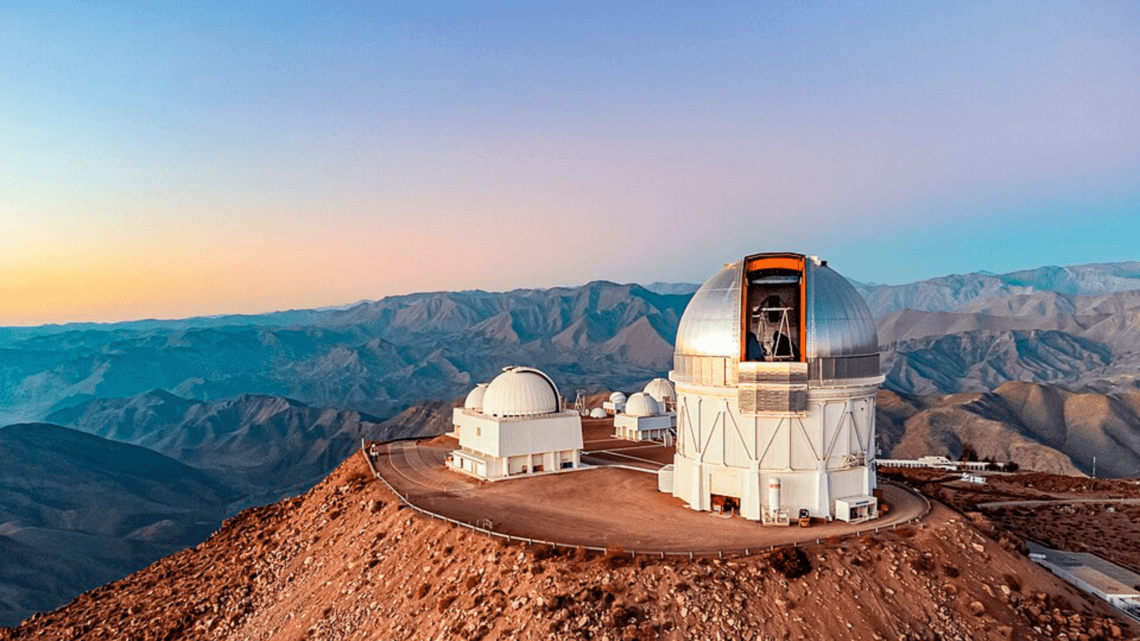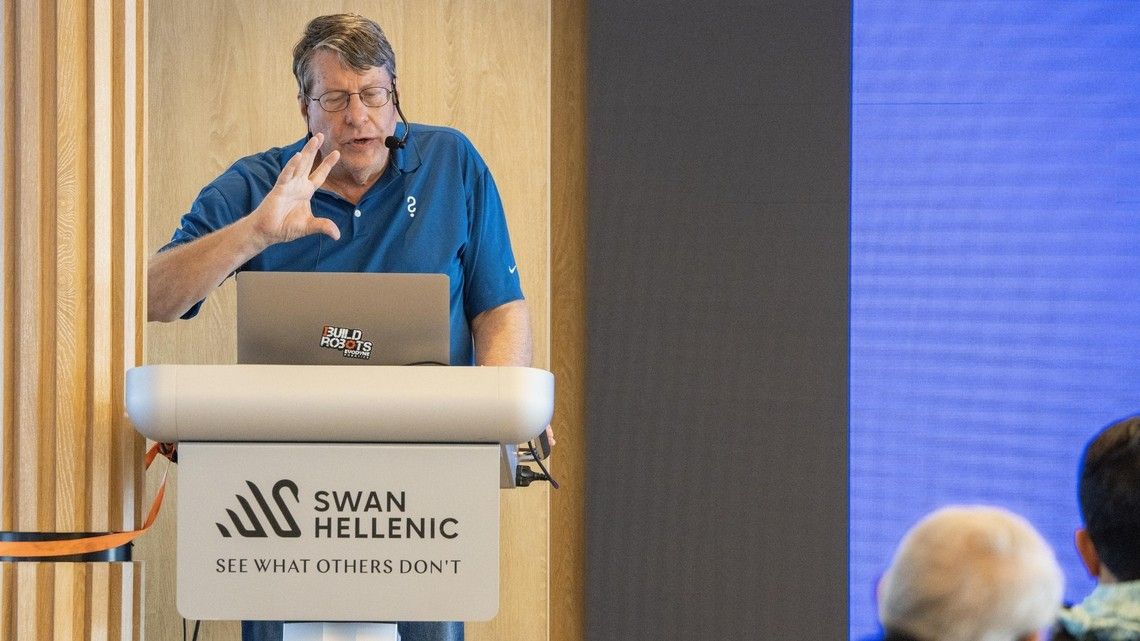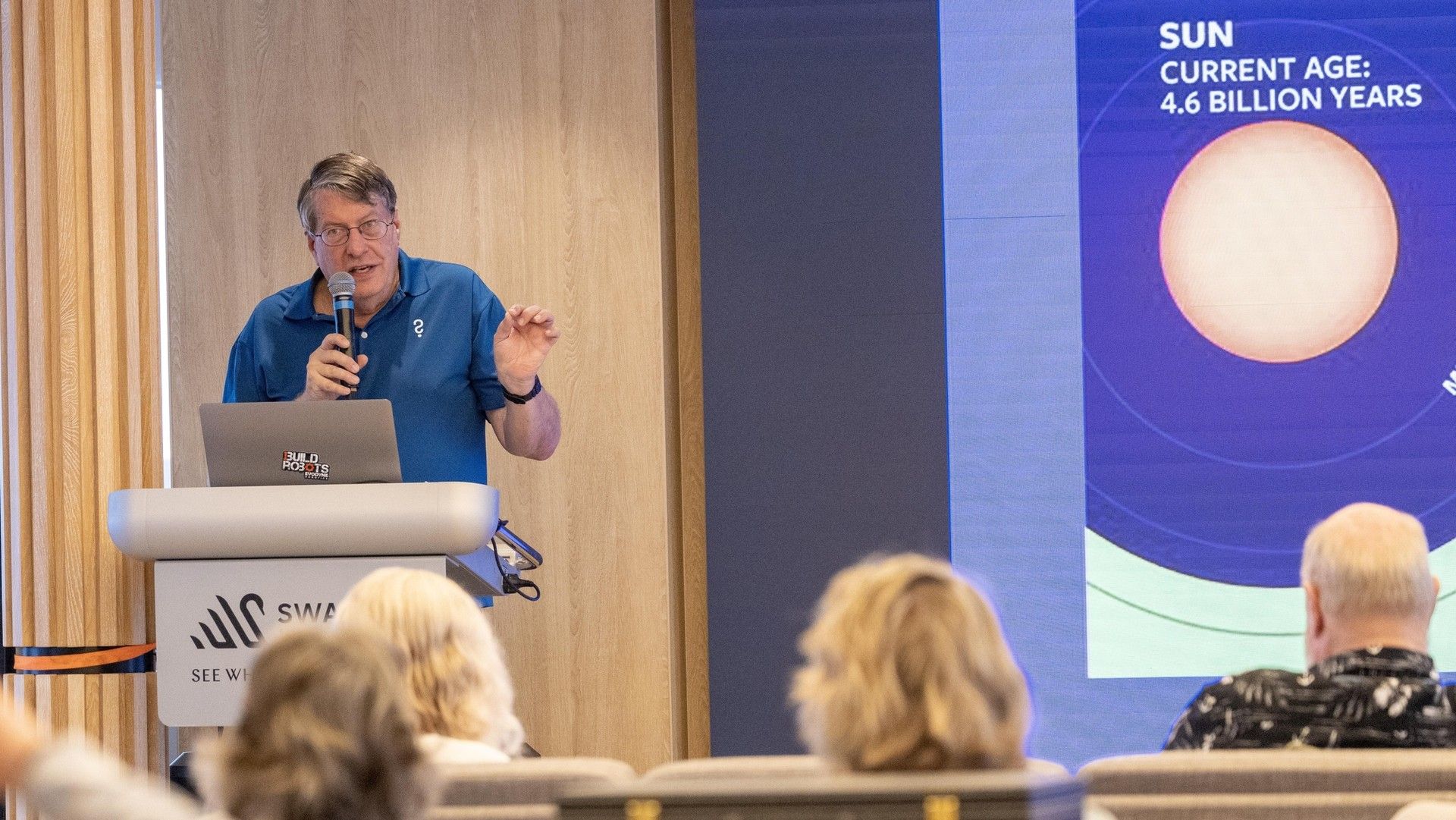"Astronomy helps people understand how we know what we know – and why science still matters."
"The carbon, oxygen, and nitrogen in us were cooked in the cores of red giant stars long before Earth even formed."
From flying aboard NASA’s SOFIA 747 observatory to decoding the atmospheres of exoplanets, astronomer Dana E. Backman translates complex cosmic discoveries into compelling narratives for students, teachers, and lifelong learners alike. He also brings decades of stargazing and scientific storytelling to travelers aboard Swan Hellenic cruises. His career spans NASA, academia, and the SETI Institute – but his love for the cosmos started at home under the night sky…
Hi Dana! What sparked your love for astronomy?
Dana: My passion began early. My father, a self-taught blue-collar worker, knew the constellations and taught me using a small planetarium kit he gave me for my birthday. Around the same time, the first astronauts and cosmonauts were journeying into space, and that excitement led me to soak up everything I could learn about space science and astronomy.
What does your role in the NASA AAA program involve?
Dana: I support science teachers – middle school through community college – with professional development and subject enrichment. Astronomy may deal with distant objects, but it’s one of the most accessible sciences. It seems now that science, and even the very idea of expertise, are under attack. It’s my experience, in and outside the classroom, that astronomy helps people understand how science works.
How did your journey with the SETI Institute begin?
Dana: As a kid, I was fascinated by life in the universe. In college, I found a copy of 'Intelligent Life in the Universe' by Iósif Shklovskii and Carl Sagan, and read and re-read it until I had it memorized! Decades later, I was hired by SETI to direct education and outreach for NASA’s SOFIA airborne observatory mission (the Institute had a subcontract with NASA to manage that program). So, after decades of wanting to be connected with the SETI Institute, suddenly and unexpectedly the opportunity presented itself. I even left a tenured professorship to take the job.
Why is Chile such an astronomy hotspot?
Dana: First and foremost, the dry climate in the Atacama Desert and surrounding regions produces the perennially clearest skies in the world. Second, the Chilean observatory mountains are at low latitudes, ranging from 24 to 31 degrees S; the closer an observatory is to the equator, the larger a fraction of the entire sky it can access during the course of a year. Third, there are many good observatory sites close to the coast near sizable cities, such as Antofagasta, providing easy logistical support and sources of personnel for observatory construction and operations. I’ve been there seven times and each time I go, the perspective I already have is reinforced by the beauty of the southern hemisphere skies.

Star-gazing at sea
What’s it like sharing astronomy on a cruise ship?
Dana: I wasn’t expecting to give night sky-gazing talks, but I was delighted to be able to do so (one onshore, three onboard). I think the people who attended the daytime lectures came out at night and brought their friends, and we all had a great time. Among many other sights, I was able to point out Mars, Jupiter, and the Orion Nebula. It’s worth noting that, for passengers from North America or Europe, half of the southern hemisphere sky featured constellations and stars they had never seen – or even heard of – before.
How do you tailor your talks for different listeners?
Dana: In the past year, I’ve spoken to scientists, teachers, retirees, and college students. I think I’m pretty good at adapting my communication style for different audiences. I always encourage questions – they help me tune my talk to the audience as I go along. And once people know I don’t bite, the questions usually come thick and fast.
You discuss topics like ocean worlds and extraterrestrial water in your lectures. Which recent discoveries excite you the most?
Dana: Light from of extra-solar planets gathered by the Webb Space Telescope has revealed several Jupiter-sized planets with water vapor in their atmospheres – it’s only a matter of time before an Earth-sized exoplanet is found to be water-bearing. Also, the Curiosity rover on Mars has analyzed rock samples and found clays that likely formed at the bottom of an ancient Martian lake. Meanwhile, observations of the Moon by the SOFIA observatory have revealed that significant amounts of water are bound to lunar soil particles. In other words, water is turning up everywhere.
What can Mars and Venus teach us about Earth’s fate?
Dana: Venus shows a "runaway greenhouse" future – Earth’s eventual destiny due to the Sun’s evolution, regardless of what humanity does or does not do. Mars shows the results of a "runaway refrigerator" effect, a process unlikely to affect Earth in the future. However, Earth did experience episodes in the past that geo scientists refer to as “Snowball Earth” events, which can be compared to aspects of Mars’s history. One important point is that there’s evidence both Mars and Venus originally had oceans but eventually lost them. Only Earth has retained its oceans.
What stories resonate most with guests?
Dana: I have the "professor disease" – there's never enough time for all my stories! As in my books, I try to emphasize how we know what we know, and how the elements of life on Earth are found throughout the Universe. Luckily, on the ship, there's always time for more stories over dinner and drinks!
What do you hope Swan Hellenic guests take from your lectures?
Dana: Swan Hellenic guests are already curious about the Universe. I hope they leave with more than just interesting facts – hopefully, with a sense of the interconnectedness of humans, Earth, and the cosmos.

Picture courtesy of Willy Alfaro, Biologist and Environmental Consultant.
Making science accessible
You’ve helped develop college textbooks. How do you make complex ideas click with beginners?
Dana: My textbooks are intended for first-year college students not planning to pursue science majors – science- and math-phobic people, if you will. My approach has been to keep the books very light on mathematical content but use sophisticated language – in other words, not “dumbed down” but aimed at students in the humanities. The two themes threaded throughout the books are: (1) How do we know what we know? and (2) What’s the history of the atoms in our bodies? I find these to be engaging themes for all students, science-oriented or not.
What advice would you give to space-loving students and educators who dream of working in a place like the SETI Institute?
Dana: I get questions similar to this when I speak to school groups. The students expect me to say the obvious – to focus on your math and science courses. What I say instead surprises them – that, in an ordinary day as a scientist, I spend 70% of my time writing, 25% talking, and 5% (at most) doing math. So, study your language arts and literature if you want to be a good scientist! (As the Jodie Foster character said in the movie Contact, “They should have sent a poet!”)
Tell us about your work with the SOFIA mission – a flying observatory aboard a Boeing 747…
Dana: I joined the SOFIA mission in 2003 as director of the mission’s education and public outreach programs. One of my responsibilities was producing news releases about SOFIA’s discoveries for the public, so I continued my practice – from my work as a college professor and textbook author – of translating frontier astronomy research into layperson terms. My main responsibility was taking science teachers on SOFIA flights so they could witness scientists in action, understand how research projects are designed and conducted, and take that knowledge and those experiences back to their classrooms. My 52 flights bringing teachers on SOFIA were an unforgettable experience.
With decades in research and education, what’s one concept in astronomy that still blows your mind?
Dana: The idea that the carbon, oxygen, and nitrogen atoms in us and other living things were cooked up in the cores of red giant stars long before the Sun and Earth formed – and that atoms of precious metals such as gold, silver, and platinum in our jewelry were created in a few seconds during supernova star explosions.
Given your role with the SETI Institute, do you think we’re close to discovering alien life?
Dana: Well, I don’t do research any longer, and my field of study was star and planet formation, so I’m not an expert on the current frontiers of astrobiology. However, my moderately informed opinion is that eventually we will find signs of microbial life elsewhere in the Solar System – but it will be recognizably related to (of a common origin with) Earth life, rather than independently developed life. I think there is some chance, during our lifetimes, that Webb or a more advanced future space telescope will find signs that some exoplanet has a non-equilibrium atmosphere like Earth’s – indicating the presence of a biosphere – but I won’t hold my breath!

Onboard insights
How do you think citizen scientists and amateur astronomers will contribute to astronomy in the future?
Dana: Astronomy is truly special among the sciences in that citizen scientists and amateur astronomers can still make significant contributions. I think the enormous amounts of publicly available data that will be coming from facilities such as the Rubin Telescope, and its Legacy Survey of Space and Time will allow that to continue.
Any special an unexpected audience questions that have stayed with you?
Dana: One evening the Expedition leaders asked me to substitute for a local astronomer who was unable to support the onshore sunset and star-gazing excursion. That night we went to an extremely dark location, and I pointed out constellations and stars while an Andean music ensemble played in the background. I received two especially memorable questions: 1) What’s the farthest thing we can see tonight? I pointed to the Large Magellanic Cloud, 150,000 light-years away (which, by the way, can only be seen from the southern hemisphere). And 2) What would our Sun and Solar System look like from a distance? I pointed to Alpha Centauri and said, that star, 4 light-years away, is almost a duplicate of our Sun. If we were standing on a planet orbiting that star, our Sun would have that same brightness and color.
If you could take guests on a cruise to any space destination, where would it be?
Dana: Saturn’s moon Hyperion. Its orbit is inclined to the plane of Saturn’s rings, so the rings would be visible, tilted to our view, 13 times wider in apparent size than Earth’s Moon is from Earth!
Did you ever imagine that you’d end up working so closely with NASA and SETI — and teaching under the stars aboard polar expedition cruises?
Dana: I’ve worked with NASA for over 36 years in different roles. I’ve wanted to be a cruise ship speaker since going on an eclipse-watching cruise to Baja California in 1991 – several senior colleagues were guest speakers on that trip. I’m thrilled it’s finally happened!
